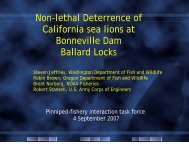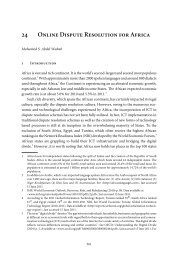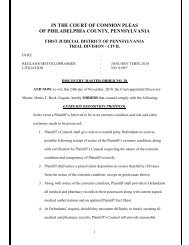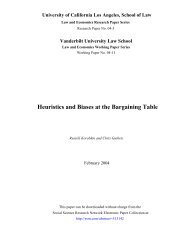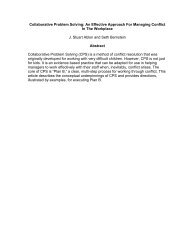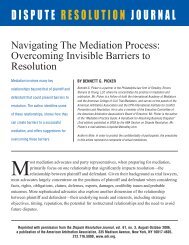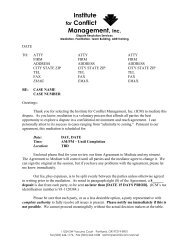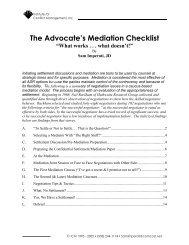17 e-Mediation - Mediate.com
17 e-Mediation - Mediate.com
17 e-Mediation - Mediate.com
Create successful ePaper yourself
Turn your PDF publications into a flip-book with our unique Google optimized e-Paper software.
<strong>17</strong> e-<strong>Mediation</strong><br />
Certainly this is just one reading of the flowchart connecting <strong>com</strong>munication theory and<br />
mediation models and orientations, and empirical research is needed. However, the little<br />
research conducted tends to uphold this.<br />
Anne-Marie Hammond 52 conducted an experiment based in a series of e-mediation simulations.<br />
Her findings were based on surveys and focus groups conducted with the mediators<br />
and with the parties. Some of her findings have important implications to the topic of<br />
worldview, orientation and media affects. In her study, most of the mediators, who typified<br />
their “normal” (i.e., face-to-face) approach as a hybrid facilitative/evaluative approach,<br />
reported that they were able to maintain this style of mediation in the online setting.<br />
However, mediators who defined their “normal” approach as being of a more facilitative<br />
nature reported that in the online setting they were more directive and also tended to use<br />
more problem-solving techniques – hinting at their being more evaluative. Most explained<br />
these shifts as necessary to “maintain momentum”. Others said they were more active in<br />
order to be heard in the non-reactive silence of online <strong>com</strong>munication. Interestingly, some<br />
disputants <strong>com</strong>mented that would have preferred even more proactive and directive<br />
mediator interventions.<br />
These findings are telling indeed: something in the online environment is conducive to<br />
mediators be<strong>com</strong>ing problem solving and directive, while at the same time conditioning<br />
parties to accept or desire this approach. This would seem to be a practical implication of<br />
the task-oriented mindset and the analytical-rational – favoring mode online <strong>com</strong>municators<br />
– mediators and parties alike – are subtly nudged into by the medium.<br />
Another way in which the online environment leads mediators away, on a very practical<br />
level, from a transformative approach and towards a problem-solving approach is that the<br />
low degree of interactivity in asynchronous modes of <strong>com</strong>munication 53 shifts focus away<br />
from the conversational dynamic and onto the issue at hand. This is the <strong>com</strong>munication<br />
theory behind Hammond’s description that:<br />
There was 100 percent agreement by mediators that the asynchronous nature<br />
of online <strong>com</strong>munications helped them to focus on the broader picture of the<br />
conflict and not just the moment-to-moment interactions. For example, they<br />
did not have to concern themselves with interruptions from disputants. 100<br />
percent (of the mediators) also agreed that having time to craft their responses<br />
enabled them to express their questions and <strong>com</strong>ments effectively. All consid-<br />
52 A.M.G. Hammond, “How Do You Write ‘Yes’? A Study on the Effectiveness of Online Dispute Resolution”,<br />
Conflict Resolution Quarterly (2003) 20, 3.<br />
53 See Ebner et al. (2009).<br />
385



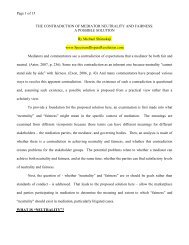
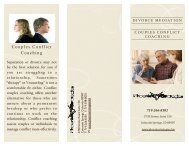
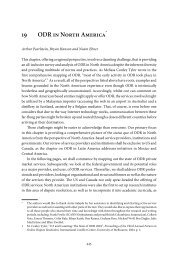
![Settlement Agreement Form [Agreement] - Mediate.com](https://img.yumpu.com/50682143/1/190x245/settlement-agreement-form-agreement-mediatecom.jpg?quality=85)
